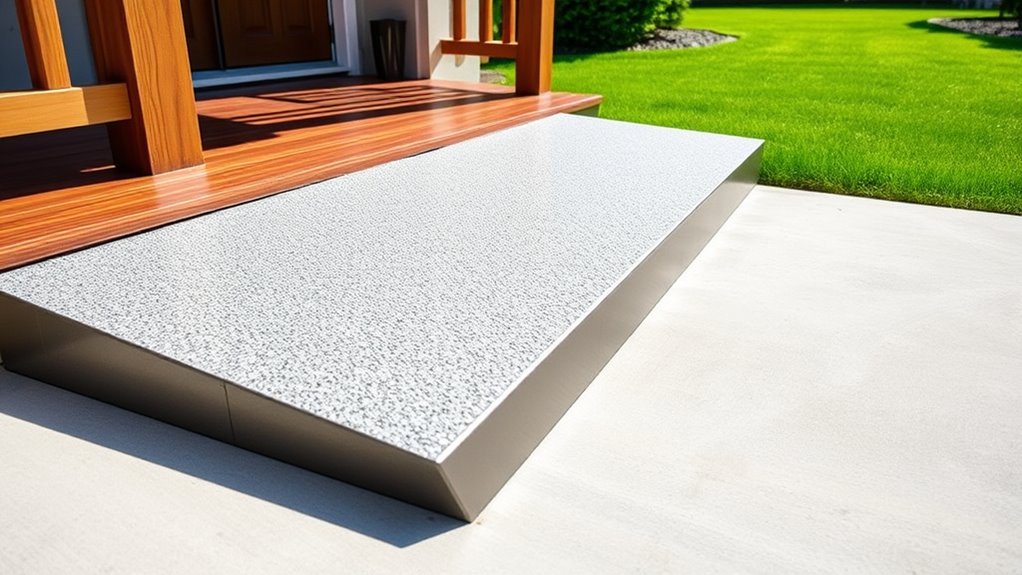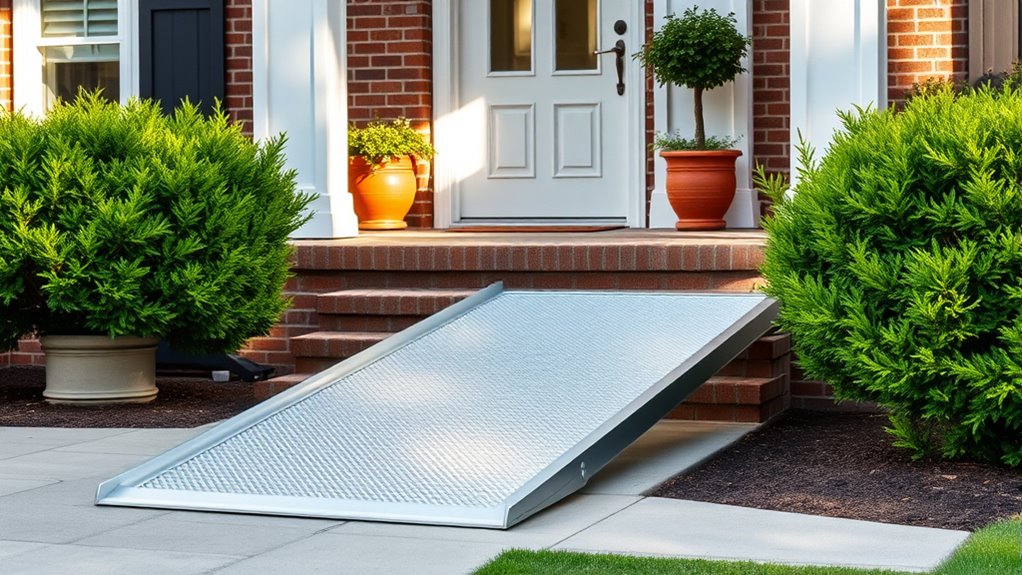When choosing the best ramp for your home entrance, prioritize safety, convenience, and your specific needs. Consider portable options like lightweight aluminum or foldable designs for flexibility and easy storage, especially if you need to move the ramp frequently. Think about the material—aluminum is durable and rust-resistant, while steel offers more weight capacity. Don’t forget to check for non-slip surfaces to ensure traction. Keep these factors in mind, and you’ll find the perfect solution—you’ll discover more helpful tips ahead.
Key Takeaways
- Assess the ramp’s weight capacity and durability based on usage and load requirements.
- Choose lightweight, portable materials like aluminum for easy transport and temporary needs.
- Consider outdoor environments and select rust-resistant materials such as aluminum or treated steel.
- Ensure the ramp surface has non-slip textures for added safety and traction.
- Match the ramp’s size and slope to your home entrance’s specific height and space constraints.

Choosing the right ramp for your home entrance is essential to guarantee safety, accessibility, and convenience. When considering options, portable solutions often stand out because they offer flexibility and ease of use, especially if you need to move the ramp frequently or store it away when not in use. These solutions are ideal for temporary needs or situations where a permanent installation isn’t practical. Portable ramps come in various forms, like foldable or telescoping designs, making them lightweight and manageable for most users. They’re perfect if you want a quick, adaptable way to navigate steps or uneven surfaces without committing to a permanent structure.
Portable ramps offer flexible, easy-to-move solutions for temporary or adaptable home access needs.
Material options are equally important when selecting the best ramp for your home. The materials used determine durability, weight, and safety. Aluminum is a popular choice because it combines strength with lightweight convenience, making portable solutions easier to carry and set up. It’s also resistant to rust and corrosion, which ensures longevity even in outdoor environments. Steel ramps are another durable option, offering greater weight capacity and robustness but tend to be heavier, which could affect portability. For indoor use, wooden ramps can blend seamlessly with home decor and are easier to customize in size and shape, though they may require more maintenance to prevent rot or splinters. Some ramps incorporate non-slip surfaces or textured finishes, which enhance safety by providing better traction, especially in wet conditions.
When choosing among material options, consider how often you’ll use the ramp and where you’ll place it. If you need a ramp that’s easy to transport and store, go for lightweight materials like aluminum or composite options. If the ramp will stay in place long-term and support heavier loads, steel or sturdy wood might be more suitable. Additionally, think about weather exposure—outdoor ramps should be resistant to rust and corrosion, making metal options more practical. The surface texture also plays a role; a smooth but non-slip surface ensures safety during use, particularly for individuals with mobility challenges. Moreover, understanding material properties can help you select a ramp that best fits your environment and lifestyle.
Ultimately, selecting the right ramp involves balancing portability, material strength, safety features, and your specific needs. Portable solutions with the right material options can provide a safe, accessible, and convenient way to overcome stairs or uneven terrain at your home entrance. Take time to evaluate your space, mobility requirements, and environmental factors to make an informed choice that enhances your independence and peace of mind.
Frequently Asked Questions
How Do I Determine the Right Ramp Length for My Entrance?
To determine the right ramp length, start by considering the ramp slope, which should be gentle enough for safety—typically 1:12 ratio (1 inch of rise for every 12 inches of length). Measure your entrance’s height and ensure the ramp can support the weight capacity needed for your wheelchair and user. This way, you’ll choose a ramp that’s safe, functional, and appropriately long for easy access.
Are There Specific Materials Recommended for Outdoor Ramps?
For outdoor ramps, you should choose weather-resistant materials like treated wood, aluminum, or composite. Make sure they have non-slip surfaces to prevent accidents, especially in wet conditions. These materials withstand the elements and provide durability over time. Non-slip textures, such as textured rubber or stamped patterns, enhance safety. Opting for weather-resistant, non-slip surfaces ensures your ramp remains safe, sturdy, and reliable regardless of weather changes.
What Maintenance Is Required to Keep Ramps Safe and Durable?
To keep your ramps safe and durable, prioritize regular ramp cleaning to remove dirt and debris that can cause slips. Check slip resistance frequently, especially after bad weather, and add non-slip treatments if needed. Keep an eye on surface wear and tighten any loose hardware. These simple steps guarantee your ramps stay secure and reliable, providing safe access without unexpected surprises.
Can Ramps Be Customized to Fit Uneven or Irregular Surfaces?
Yes, ramps can be customized to fit uneven or irregular surfaces through various customization options. You can choose adjustable or modular ramps that adapt to different terrains, ensuring surface adaptation for stability and safety. Custom features like custom heights, widths, and non-slip surfaces help create a perfect fit for your unique entrance. With proper planning, your ramp will provide a secure, accessible solution tailored to your specific uneven or irregular surface.
How Do I Ensure Ramps Comply With Local Building Codes?
To stay on the right side of the law, you need to do your homework first. Check that your ramps meet ADA compliance standards and verify permit requirements with local building authorities. Think of it as crossing all your T’s and dotting your I’s—this ensures safety and legality. Keep detailed records and consult professionals if needed, so your ramps aren’t just functional but also fully compliant with local codes.
Conclusion
Choosing the right ramp makes your home safer and more accessible. Don’t let concerns about installation or cost hold you back—many ramps are easy to set up and affordable. Remember, investing in the right ramp improves independence and peace of mind for you and your loved ones. So, take the time to select the best option for your needs, and enjoy a more inclusive, barrier-free home environment today.









